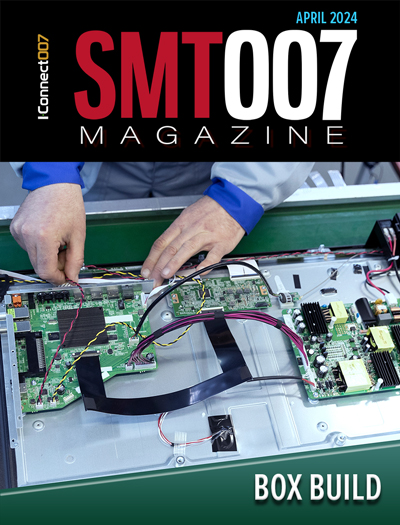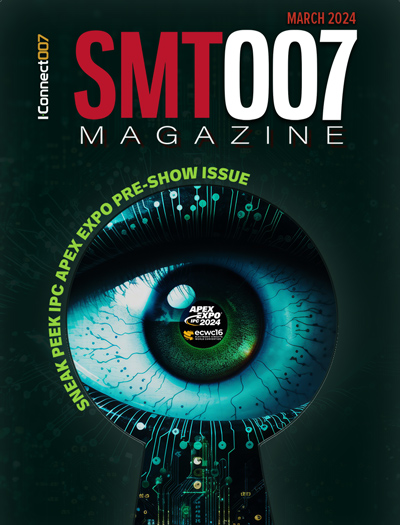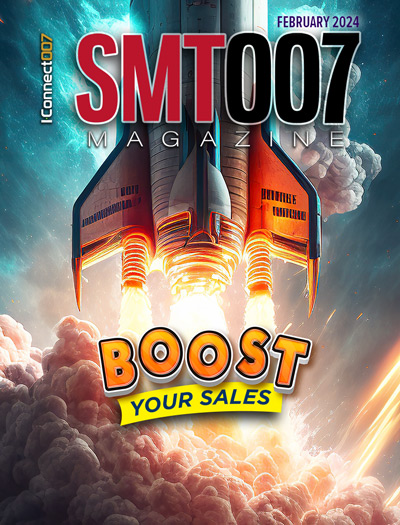-

- News
- Books
Featured Books
- smt007 Magazine
Latest Issues
Current Issue
Box Build
One trend is to add box build and final assembly to your product offering. In this issue, we explore the opportunities and risks of adding system assembly to your service portfolio.

IPC APEX EXPO 2024 Pre-show
This month’s issue devotes its pages to a comprehensive preview of the IPC APEX EXPO 2024 event. Whether your role is technical or business, if you're new-to-the-industry or seasoned veteran, you'll find value throughout this program.

Boost Your Sales
Every part of your business can be evaluated as a process, including your sales funnel. Optimizing your selling process requires a coordinated effort between marketing and sales. In this issue, industry experts in marketing and sales offer their best advice on how to boost your sales efforts.
- Articles
- Columns
Search Console
- Links
- Events
||| MENU - smt007 Magazine
Fairlight: An Iconic Name in Digital Audio
August 3, 2015 | Barry Matties, I-Connect007Estimated reading time: 7 minutes
The Australian company Fairlight Instruments became one of the biggest names in the recording industry with its digital sampling technology in 1975. Forty years later, the company is still leading with a full line of products that their technologists design, engineer in house, and produce with a network of EMS companies. In this interview, Business Development Manager Emilijo Mihatov shares insights and strategies for succeeding by thinking differently.
Barry Matties: Please share a bit about the history of Fairlight.
Emilijo Mihatov: Fairlight has been making professional audio tools for musicians and audio professionals for 40 years. Back in the late '70s we invented the keyboard sampling system and we sold it to people like Kate Bush, Peter Gabriel, Pink Floyd and Stevie Wonder.
Matties: All of the heavies of that time.
Mihatov: All the big heavies bought our sampler. It was a very expensive system. Then people started using our system for film post-production, because we have very good synchronization capabilities. Some good examples of that are "Beverly Hills Cop" and "Miami Vice." They used Fairlights for the soundtracks for every single sound. There's one famous album credit that we have for Phil Collins' "No Jacket Required." If you look at the back, you'll see he has a credit that says, "No Fairlights were used on this album." We were so ubiquitous that people were actually forming movements to stop using this thing.
We got into the audio post business and then we basically took over Hollywood. You couldn't go into a dub stage in Warner Brothers, Sony, or Glen Glenn Sound without seeing Fairlight's equipment. One of the products I was responsible for was the digital audio dubber (DaD), which revolutionized the way films were mixed. Suddenly, you could go from having mixes that were maybe 30 tracks wide to having mixes that were 576 tracks wide. We won an Oscar for that; Renee Zellweger presented it. I got to hold the statue and have my photo taken.
One of the reasons our products were so successful was that we had dedicated hardware control surfaces, and there was a dedicated key for every function. As the software got more and more complex and people were requiring more and more features, it became more difficult to have a button for every feature, so you had to have layers which meant that you started having hidden functions.
Matties: There's some complexity there.
Mihatov: There was complexity, so we had to come up with a way of solving that. Another problem that we had was that we were becoming very successful in Asia. A lot of our customers were demanding that we produce control surfaces that were in kanji characters. Having a different sort of bill of materials and a different control surface for every region is not a very efficient way of doing business. Our CTO, who just thinks on a completely different level than normal human beings, came up with the idea of having a self-labeling keyboard. He sort of sought out the technology from Incom and created the control surfaces that we use here.
The concept behind this is that you have different modes. For quick edit, you have a palette of commands that are here. For basic edit, you have a different palette of commands. If you're in mixing, you have another palette. If you need to type something, it will switch back to a QWERTY keyboard and you can type it. If you need a numeric keyboard to enter the time code location, you hold down a button and then a numeric keypad appears. When you don't need it anymore, it's gone.
You can have many layers of functions but what happens is that the operator ends up developing a motor memory for these functions. After using the equipment for a short period, they stop looking at it.
Page 1 of 3


